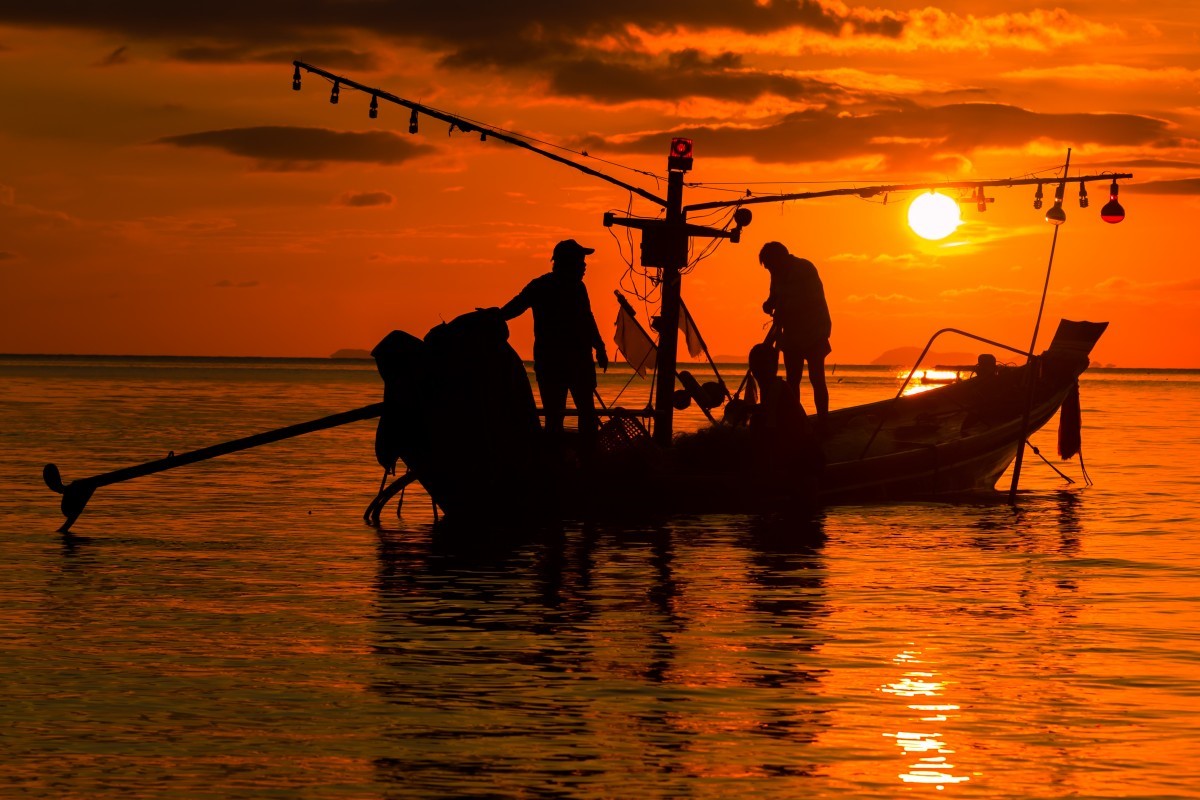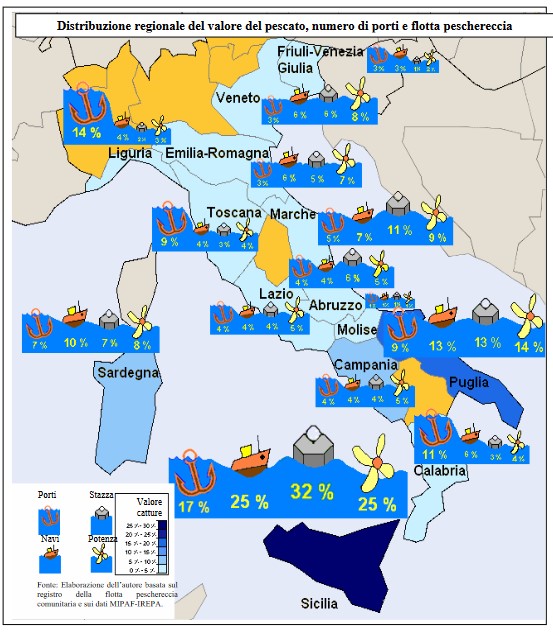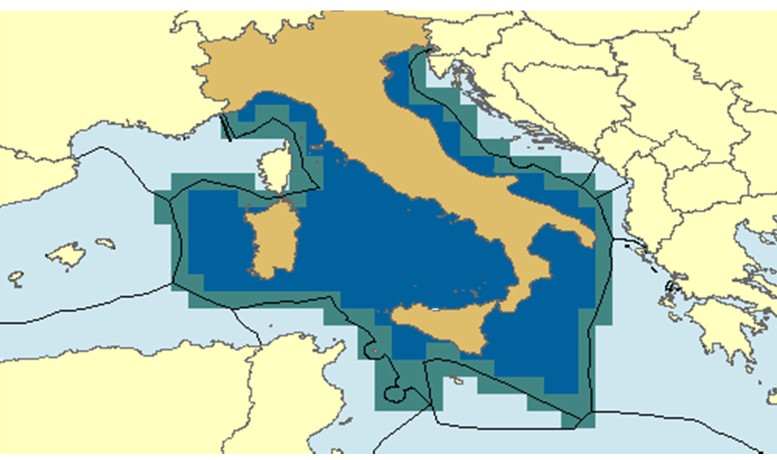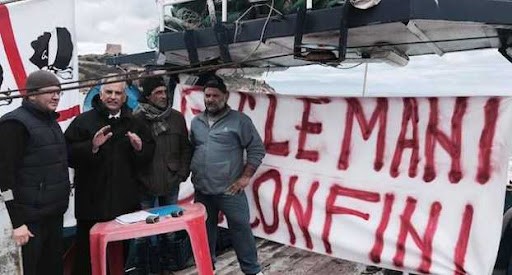
In the last ten years, six governments have led Italy. These six governments are responsible for causing a possibly unsolvable crisis in the Italian fishing industry: and they have done so out of incompetence and sloth. While Matteo Renzi’s dreams of new drilling died with the referendum against oil exploitation in our waters, Luigi Di Maio and Giuseppe Conte are responsible for doing nothing to prevent a disaster. If, on the Italian side, confusion currently reigns, and the European Union refuses to take a position, the French and the United Nations are putting their acquired rights into practice – and this gives the governments of Croatia, Algeria, Tunisia, Turkey and Libya the opportunity to swoop down with impunity almost in front of the ports of Sicily. An intolerable situation, and not just because of the great seafaring traditions of our people: we too have a population to feed…
When, on 2 October 1935, Benito Mussolini replied to an official letter from the League of Nations, condemning Italy for its aggression against Abyssinia, he described Italians as ‘a people of poets, artists, heroes, saints, thinkers, scientists, navigators, of transmigrators” – a phrase to defend the pride of the young country (a united Italy had just turned 65), which was engraved on the Palazzo della Civiltà, in the EUR district, built by Fascism for the 1942 Universal Exhibition, cancelled by the war, and which would be completed in 1960 for the Roman edition of the Olympic Games[1].
The Duce forgot to add: of fishermen. After thousands of years of fishing being a subsistence activity linked to life on the coast, in 1866, after the conquest of several ports on the Adriatic and the defeat of the Austro-Hungarian fleet, which also traded in salted fish with the inland provinces of the Empire, the young Italian nation, torn apart by war, misery and backward infrastructure, discovered fishing as an industrial activity. Ten years later, fishing companies set up in the ports of the northern Adriatic (Istria, Friuli and Veneto) catch, salt, smoke and sell 90 tonnes of fish a year – in a nation whose total is 240 tonnes, only because the populations of Sicily and Sardinia live almost exclusively on this[2].
The numbers of decline

Statistical overview of fishing in Italy[3]
But this is not the only reason: the Adriatic Sea is richer in fish than the Tyrrhenian Sea, so after the Second World War, the Italian fishing industry started from this sea and developed thanks to technical improvements in fishing itself and in systems for preserving and processing fish[4]. After the golden years, around 1970, intensive fishing severely reduced the Mediterranean fauna, so that all countries – including Italy – even though 69% of fishermen still work in the catching sector[5], began to invest in captive fishing, so much so that, in the last 10 years, Italy, Spain and Poland have received EU aid of over 320 million, or almost 40% of European spending on fishing[6].
As a result, the Italian fishing fleet has decreased by about a third since 1995[7], leaving the Adriatic for Sicily, which alone accounts for about a third of the total tonnage[8]. This reduction has been offset by an increase in the number of fish caught per boat and an increase in market prices, which have risen from € 0.5 per kilo in 1976 to € 3.5 per kilo in 2009 and € 5.9 per kilo in 2019[9]. The quantity of Italian fish continues to decrease (230,000 tonnes in 2010, 177,000 tonnes in 2019), while consumption is growing and, therefore, an increasing percentage of the fish products consumed on Italian tables comes from abroad, especially from the Norwegian and Icelandic fleets[10].
Reversing the trend would require a structural change, which is unthinkable at present. The fact that mankind has plundered and poisoned the seas is not just an issue related to the Mediterranean, but it is a problem on a global scale that has caused, over the last 80 years, a profound transformation of the entire sector: important figures are being caught by fleets capable of fishing in international waters and at great depths: Such a fleet cannot be improvised, it costs enormous sums of money and it is now faced with countries such as China, whose fishing industry puts 81 million tonnes of fish on the market every year, three quarters of which comes from aquaculture[11].
But there are 84 million tonnes of fish caught in the international waters of the Pacific Ocean[12] by Indonesian, Indian, Vietnamese, Russian and American fleets – while the total Italian fishing industry struggles to reach 0.2 million tonnes per year, which puts us over 50% of the world’s top fishing countries[13]. To this must be added the calculation of the United Nations agency for food problems (FAO), which considers the official data not to be credible, and fears that there is 30% more fishing coming from international waters, and caught in open violation of all international treaties[14]. FAO tries to monitor the situation as best it can, but the only tangible result is an endless series of reports on the disappearance of fishing from an ever-increasing number of marine areas[15].
For this reason, the political, diplomatic and military struggle over territorial waters, especially in a restricted area like the Mediterranean, has become a ruthless fight for survival, because the most profitable areas for shellfish, blue fish and the few remaining tuna make all the difference: if they are not defended, our fishermen will disappear within a generation, and Italy will become the only nation in the world surrounded by the sea and without a fishing industry.

The fish map of Italy: in blue the territorial waters and the Exclusive Economic Zones, in green those assigned by the Treaty of Montego Bay in 1982, the black lines define the current official boundaries, the green areas are those over which there are disputes[16]
According to the agreements made after the Second World War, each nation is guaranteed the inviolability of its territorial waters: these extend for 12 nautical miles (about 22 km) from each coast, as finally established by the United Nations Convention on the Law of the Sea (Montego Bay Treaty) on 10 November 1982, after years of exhausting negotiations directed by the Maltese Arvid Pardo, who is the father of world peace on the sea[17]. Beyond that small stretch of sea, the Treaty of Montego Bay provides for the creation of Exclusive Economic Zones (EEZ), 370 km (200 nautical miles) [18] wide and obviously colliding with each other: since it is a UN agreement, the management of the EEZ is entrusted to one of its agencies – the FAO Food and Agriculture Organization, based in Rome[19].
Italy is assigned one EEZ, which includes the Adriatic, Ionian, Tyrrhenian, Sardinian, Sicilian and Ligurian Seas[20]. While this agreement was accepted by Yugoslavia and African countries in 1982 due to their political weakness and the lack of a fleet capable of countering Italian fishermen, things have changed considerably over time, and in recent years both Croatia and Algeria have put forward claims for the extension of their own EEZ[21].
In order to resolve the issue, these two countries submitted a formal request to the United Nations, and Italy was asked for a formal response, which was also submitted to the United Nations, which then sought mediation and made a decision. If Italy had not responded, the request from the country making the claims would have been considered accepted and included in FAO’s maps: a procedure strongly criticised by all the fishermen’s associations, but still in force[22].
The Caen agreements

Mauro Pili, Member of Parliament for the Region of Sardinia, coordinates Sardinian fishermen’s protests against the Caen Agreement[23]
The alternative is to resolve disputes through bilateral negotiations, as France and Italy have done, with a negotiation that began in 2009 and ended with a Treaty, the Caen Agreement, on 21 March 2015: “an agreement concerning the definition of maritime borders, redetermining the demarcation lines between Italian and French territorial waters and the areas under national jurisdiction beyond the territorial borders”[24]. A treaty signed by Foreign Ministers Paolo Gentiloni and Laurent Fabius, Prime Minister Matteo Renzi and French President François Hollande – an agreement coveted by Paris, which for its fishermen gets extremely fishy areas of the Ligurian Sea[25], the Sardinian Sea and even the Tyrrhenian Sea, in exchange for deeper waters in which the Renzi government hopes to find gas, oil and strategic minerals[26]. Hopes never turned into reality.The violent reactions of Italian fishermen, after the fall of the Renzi government, lead to the so-called Quirinal Treaty of 26 November 2021[27], which deals with European policy, military defence, security, economy, industry, ecological and digital transition, culture, youth and even the space industry[28], but does not in any way concern the border issues defined by the Caen Agreement[29]. Although Italy has never ratified the Caen Accord, France has done so and, since the end of 2015, has regularly applied it[30].This has aroused the ire of some senators, who have addressed an interpellation to the Minister of Foreign Affairs, Luigi Di Maio, in order to understand how it is possible to assign “economic exclusivity to France over the ‘cemetery trench’, between Ventimiglia and Menton, and over several areas in the north-west of Sardinia, These areas are particularly rich in fish stocks, including valuable ones (red shrimp), and above all are vital to the economy of the areas concerned, to numerous fishing fleets and to thousands of families’. The question describes the fishermen as victims of an ‘agreement which is particularly generous to France and decidedly disadvantageous to Italy’[31]. The question states that the areas covered by the agreement, in addition to fishing activities, are important for natural resources: gas (1.4 trillion cubic metres) and oil (0.42 billion barrels) reserves[32].On 19 March 2018, Di Maio replied on the institutional website of the Ministry of Foreign Affairs: “The bilateral agreement of March 2015 has not been ratified by Italy and therefore cannot produce legal effects. The maritime borders with France are therefore unchanged and no one in Paris or Rome intends to change them. As for the date of 25 March, as the French embassy in Rome informs us, it simply concerns “a public consultation in the framework of the preparatory consultation for a strategic document” on the Mediterranean that refers to existing European law and directives and that is not aimed in any way at changing the maritime delimitations in the Mediterranean”[33].Alarm over? No, since the Montego Bay Treaty clearly explains that if a country does not ratify an agreement, and does not send a statement of opposition, the agreement is considered accepted: exactly what France has legally and rightly done, given that neither the Renzi nor the Conte governments have ever completed the required paperwork. In January 2016, the Ligurian fishing boat “Mina” was stopped by the French maritime gendarmerie on charges of fishing for red shrimp in French EEZ waters, and the Italian government, admitting its mistake, paid a fine of € 8300 to free the Genoese vessel – an unacceptable embarrassment[34], even if the French Government subsequently issued a diplomatic apology from Paris, which should have prevented it from escorting the ‘Mina’ to Nice and keeping it there imprisoned with its entire crew[35].

The Ligurian fishing vessel Mina, seized in 2016 by the French Navy[36]
On 11 February 2016, a month after the “Mina” incident, a Sardinian fishing boat, which had just left the port of Alghero to reach its usual fishing grounds in the north of Sardinia, was stopped – again on the basis of the Caen Agreement – by the French authorities[37]. The European Commission refuses to take a position, referring to international laws and fisheries agreements between EU countries[38]. This is an empty assertion, made to please no one, but it does not change the issue.
For Admiral Giuseppe De Giorgi, former Chief of Staff of the Italian Navy, the “borders between Italian and French waters remain uncertain. A recent ruling by the Imperia court acquitted a fisherman of the charge of trespassing in French waters. The court also declared the 1892 Treaty of Menton, which regulated the borders between the Ligurian Riviera and the Côte d’Azur, invalid, again because it had not been ratified by Parliament. This is a precedent that will become law, given the numerous objections made by the French maritime gendarmerie to the San Remo fishing boats”[39].
In January 2018, the French Ministry of Ecology published a document[40] showing the new maritime borders between France and Italy established by the Caen Agreement. The map enlarges French possessions to the detriment of Italy, the French government admits the mistake, apologises[41]. In the “wrong” document, the French EEZ goes as far as the island of Elba and almost as far as the island of Ponza, but the corrective document, published a few months later, includes the changes in the Caen Agreement and no Italian authority has expressed any complaint about the cession of a large part of the Ligurian Sea and part of the Tyrrhenian and Sardinian Seas[42].
Italian fishermen are too few, they have no media coverage and no political lobby. No one defends them, not even those who call themselves amateur and occasional fishermen[43] and who, over the last 20 years, have contributed decisively to the impoverishment of our marine fauna[44]. The State administration is incapable of reacting, and after all, responsibilities for the sea are divided between five ministries. In contrast to Paris, where there is a single Department of the Sea[45]. The position of the last three governments, with regard to Caen, remains that of Di Maio: Italy has signed ‘subject to further in-depth studies, at the end of which a global assessment will be made with a view to a possible start of ratification’[46]. This is not an elegant way of making it clear that no one in Rome cares about fishermen.
[1] https://www.istantidibellezza.it/il-palazzo-della-civilta-italiana.html
[2] https://circoloistria.com/la-pesca-austro-ungarica-allepoca-della-prima-esposizione-provinciale-istriana/
[3] https://www.unimc.it/maremap/it/temi/risorse-biologiche/studi-del-parlamento-europeo/la-pesca-in-italia-2008
[4] Cesare F. Sacchi, “La pesca italiana nell’Adriatico del dopoguerra”, in “Il Politico”, No. 16, volume 1, Rubbettino, Soveria Mannelli 1951, pp. 60-66; https://www.jstor.org/stable/43208739
[5] https://www.unimc.it/maremap/it/temi/risorse-biologiche/studi-del-parlamento-europeo/la-pesca-in-italia-2008, p. 3
[6] https://www.europarl.europa.eu/ftu/pdf/it/FTU_3.3.9.pdf, p. 5
[7] https://www.unimc.it/maremap/it/temi/risorse-biologiche/studi-del-parlamento-europeo/la-pesca-in-italia-2008, p. 11
[8] https://www.unimc.it/maremap/it/temi/risorse-biologiche/studi-del-parlamento-europeo/la-pesca-in-italia-2008, p. 13
[9] https://www.unimc.it/maremap/it/temi/risorse-biologiche/studi-del-parlamento-europeo/la-pesca-in-italia-2008, p. 31
[10] https://www.istat.it/it/files/2020/05/IWP-4-2020.pdf, p.9
[11] https://data.worldbank.org/indicator/ER.FSH.PROD.MT?end=2016&start=1960&view=chart&year_high_desc=true ; https://data.worldbank.org/indicator/ER.FSH.CAPT.MT?end=2016&start=1960&view=chart&year_high_desc=true ; https://data.worldbank.org/indicator/ER.FSH.AQUA.MT?end=2016&start=1960&view=chart&year_high_desc=true
[12] https://it.wikitrev.com/wiki/Ocean_fisheries
[13] https://data.worldbank.org/indicator/ER.FSH.PROD.MT?end=2016&start=1960&view=chart&year_high_desc=true ; https://data.worldbank.org/indicator/ER.FSH.CAPT.MT?end=2016&start=1960&view=chart&year_high_desc=true ; https://data.worldbank.org/indicator/ER.FSH.AQUA.MT?end=2016&start=1960&view=chart&year_high_desc=true ; https://it.wikitrev.com/wiki/Fishing_industry_by_country#cite_note-1
[14] https://greenreport.it/news/aree-protette-e-biodiversita/il-30-del-pesce-pescato-nel-mondo-non-figura-nelle-statistiche/
[15] https://www.fao.org/fishery/en/vme/search
[16] file:///C:/Users/Asus/AppData/Local/Temp/sustainability-06-07482.pdf, p.7489
[17] https://treaties.un.org/pages/ViewDetailsIII.aspx?src=TREATY&mtdsg_no=XXI-6&chapter=21&Temp=mtdsg3&clang=_en
[18] https://www.un.org/Depts/los/convention_agreements/texts/unclos/closindx.htm
[19] https://www.pescasicura.com/periodi-zone-di-pesca-e-tutela-della-specie/ ; https://fish-commercial-names.ec.europa.eu/fish-names/area_it?code=37
[20] https://en.wikipedia.org/wiki/Exclusive_economic_zone_of_Italy
[21] https://www.un.org/Depts/los/LEGISLATIONANDTREATIES/PDFFILES/mzn_s/mzn135ef.pdf ; https://www.un.org/Depts/los/LEGISLATIONANDTREATIES/PDFFILES/2018_NV_Italy.pdf ; https://www.un.org/Depts/los/LEGISLATIONANDTREATIES/PDFFILES/AlgItaly.pdf
[22] https://www.cambridge.org/core/journals/american-journal-of-international-law/article/abs/judicialization-of-the-sea-bargaining-in-the-shadow-of-unclos/1E7BDAEB4A62B1A43E5AB3456344B4F7 ; https://agriregionieuropa.univpm.it/it/content/article/31/10/mediterraneo-un-mare-di-pesca
[23] http://www.opinione-pubblica.com/argomenti/accordo-di-caen/
[24] https://www.senato.it/japp/bgt/showdoc/showText?tipodoc=Sindisp&leg=18&id=1123193
[25] https://www.limesonline.com/litalia-e-i-mari-contesi/89987 ; https://www.repubblica.it/economia/economia-del-mare/2018/04/12/news/confini_di_mare_italia-francia-191869081/
[26] https://www.ammiragliogiuseppedegiorgi.it/mc/490/laccordo-di-caen ; https://www.repubblica.it/economia/economia-del-mare/2018/04/12/news/confini_di_mare_italia-francia-191869081/
[27] https://www.governo.it/sites/governo.it/files/Trattato_del_Quirinale.pdf
[28] https://www.ilsole24ore.com/art/draghi-e-macron-firmano-trattato-quirinale-AEYvGRz
[29] https://www.askanews.it/esteri/2021/12/09/trattato-quirinale-di-maio-con-parigi-siamo-partner-irreversibili-pn_20211209_00134/
[30] https://www.lecronachelucane.it/2018/03/18/laccordo-siglato-a-caen-il-21-marzo-del-2015-e-stato-fatto-scattare-nei-giorni-scorsi-in-modo-unilaterale-dalla-francia-considerato-che-lo-ha-gia-fatto-ratificare-al-proprio-parlamento/
[31] https://www.senato.it/japp/bgt/showdoc/showText?tipodoc=Sindisp&leg=18&id=1123193
[32] https://www.senato.it/japp/bgt/showdoc/showText?tipodoc=Sindisp&leg=18&id=1123193
[33] https://www.esteri.it/it/sala_stampa/archivionotizie/comunicati/2018/03/senza-fondamento-ipotesi-cessione-mare-a-francia/
[34] https://www.repubblica.it/economia/economia-del-mare/2018/04/12/news/confini_di_mare_italia-francia-191869081/
[35] https://www.repubblica.it/economia/economia-del-mare/2018/04/12/news/confini_di_mare_italia-francia-191869081/
[36] https://www.riviera24.it/2016/01/peschereccio-sequestrato-ora-anche-per-i-francesi-era-in-acque-italiane-il-suo-capitano-oramani-la-stagione-214599/
[37] https://www.corsenetinfos.corsica/Le-mystere-des-frontieres-maritimes-franco-italiennes-fait-polemique-en-Italie_a20129.html
[38] https://www.lastampa.it/imperia-sanremo/2016/06/18/news/guerra-dei-gamberi-l-italia-difende-i-confini-1.34989912/
[39] https://www.ammiragliogiuseppedegiorgi.it/mc/490/laccordo-di-caen
[40] Document stratégique de façade Méditerranée situation de l’existant, enjeux et vision à 2030- Concertation préalable du public – Dossier du maître d’ouvrage – Janvier 2018 ; http://www.geolittoral.developpement-durable.gouv.fr/IMG/pdf/dmo_med_vfcartesmaj-2.pdf
[41] https://www.repubblica.it/economia/economia-del-mare/2018/04/12/news/confini_di_mare_italia-francia-191869081/
[42] https://www.repubblica.it/economia/economia-del-mare/2018/04/12/news/confini_di_mare_italia-francia-191869081/
[43] https://www.glistatigenerali.com/agricoltura_biologia/la-guerra-del-pesce-nel-mediterraneo/
[44] https://www.glistatigenerali.com/agricoltura_biologia/la-guerra-del-pesce-nel-mediterraneo/
[45] https://www.raiplaysound.it/audio/2018/03/TUTTA-LA-CITTAapos-NE-PARLA-8e9aa90b-3d9a-406e-bcdc-5629b3bc4bc8.html
[46] https://www.ilfattoquotidiano.it/2016/02/20/confini-marittimi-italia-francia-il-nuovo-accordo-lascia-a-parigi-le-zone-piu-pescose/2481346/
Leave a Reply